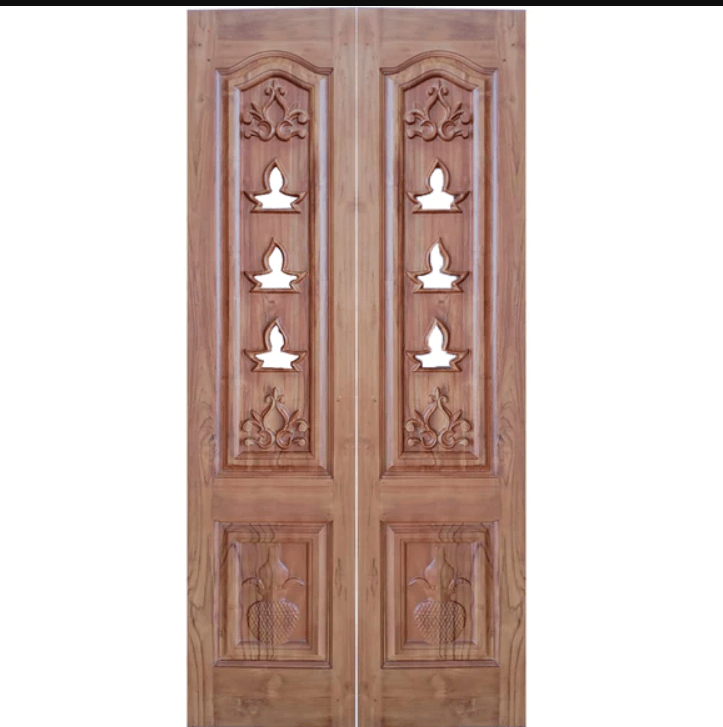The pooja room is a sacred space in a home, a place for prayer, meditation, and connection with the divine. Every element within this space should contribute to a sense of peace, serenity, and spiritual focus. The door to your pooja room plays a significant role in setting the atmosphere. Here, we explore some stunning door ideas to elevate your pooja room and create a truly special sanctuary.
Material Marvels:
Wood: A timeless choice, wooden doors offer warmth, beauty, and a sense of tradition. Consider teak, known for its durability and resistance to warping, or mango wood, prized for its rich color and intricate grain patterns.
Metal: Brass doors exude elegance and symbolize purity. Ornate designs with intricate carvings can add a touch of grandeur, while simple, clean lines provide a more contemporary feel.
Marble/Granite: For a luxurious and sophisticated touch, consider natural stone doors. These wooden doors prices are exceptionally durable and can be crafted with beautiful inlay work or carvings depicting deities or religious symbols.
Design Delights:
Traditional Carvings: Doors adorned with intricate carvings depicting gods, goddesses, or auspicious symbols like Om or kalashas instantly elevate the spiritual ambiance of your pooja room.
Floral Motifs: Delicate floral carvings or patterns etched on the door introduce a sense of peace and tranquility, reflecting the beauty of nature often associated with divine blessings.
Geometric Patterns: Geometric patterns like mandalas or chakras can imbue the door with spiritual significance and symbolism. These patterns can be simple or complex, adding a touch of elegance and cultural heritage.
Style Statements:
French Doors: Double doors in a French style with glass panels can create a sense of openness while maintaining the sanctity of the space. Choose frosted or etched glass for privacy while allowing diffused light to enter the pooja room Door.
Sliding Doors: Space-saving sliding doors in wood or frosted glass are a practical choice for smaller pooja rooms. They offer a clean and contemporary aesthetic that blends seamlessly with modern home interiors.
Arched Doors: For a touch of grandeur, consider an arched doorway. This architectural detail adds a sense of height and majesty to your pooja room entrance.
Functional Flair:
Door Knockers: A beautiful door knocker adds a touch of elegance and allows for a discreet announcement of arrival. Choose a design that complements the overall style of your pooja room door.
Door Handles: While seemingly a small detail, the door handle can elevate the aesthetics of your pooja room entrance. Opt for brass handles with intricate designs or sleek, modern pulls depending on your chosen style.
Doorbells: A traditional bell or a chime can be a beautiful way to announce your presence at the entrance to the pooja room, creating a sense of mindfulness as you enter the sacred space.
Additional Considerations:
Color: Consider the overall color scheme of your pooja room. Natural wood tones offer timeless elegance, while deep, rich colors like maroon or red symbolize prosperity and vibrancy. For a more modern aesthetic, consider white or cream tones.
Placement: Ensure the door opens outwards to avoid obstructing the flow of positive energy within the pooja room. If space is a constraint, consider sliding doors for a space-saving solution.
Budget: Door materials and designs can vary significantly in cost. Set a realistic budget and choose an option that complements the overall style of your pooja room without compromising on quality.
By incorporating these stunning wooden door design ideas, you can create a pooja room entrance that is both aesthetically pleasing and functionally sound. Remember, the perfect room door reflects your personal taste and spiritual beliefs, transforming this sacred space into a haven for peace, prayer, and reflection.

As the editor of the blog, She curate insightful content that sparks curiosity and fosters learning. With a passion for storytelling and a keen eye for detail, she strive to bring diverse perspectives and engaging narratives to readers, ensuring every piece informs, inspires, and enriches.










